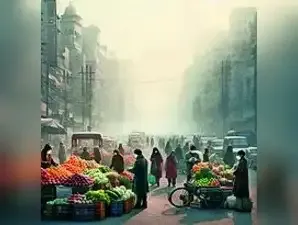When GoI launched National Air Quality Index (AQI) in 2014 as part of Swachh Bharat, it promised a simple 'one number-one colour-one description' tool to help citizens gauge the air they breathe. More than a decade on, air pollution has certainly captured public attention. But clearly not enough yet to force the scale of change the crisis demands. Public concern has grown. Public pressure has not.
This season Delhi-NCR air has been so toxic that Commission for Air Quality Management (CAQM) has activated tougher Graded Response Action Plan (GRAP) curbs : Stage 2 measures kick in at Stage 1 (AQI 201-300) and Stage 3 at Stage 2 (AQI 301-400). The new triggers mandate uninterrupted power to cut generator use, expanded public transport, staggered office hours and 50% workforce/WFH norms - a proactive response to worsening air. Unfortunately, Delhi's air-pollution crisis is self-inflicted, driven by internal sources like open burning of waste, biomass, tandoors and heating, not just stubble burn from farms. Scientific fingerprinting confirms that over half of Delhi's particulate matter (PM2.5 and PM10) comes from these local sources. Structural gaps in waste management worsen the problem. Nearly 30% of waste leaks out and is burned because of inadequate collection and processing.
Without further feet-shuffling, treat Delhi and its neighbours as a single airshed and fix these failures without delay. Bring about strict action against offenders, have consistent GRAP enforcement, improve civic services and show political will. Delhi-NCR must take collective responsibility instead of normalising its chronic air crisis. That normalisation is already eroding public health, making Delhi a far less attractive place to live, work and play.
This season Delhi-NCR air has been so toxic that Commission for Air Quality Management (CAQM) has activated tougher Graded Response Action Plan (GRAP) curbs : Stage 2 measures kick in at Stage 1 (AQI 201-300) and Stage 3 at Stage 2 (AQI 301-400). The new triggers mandate uninterrupted power to cut generator use, expanded public transport, staggered office hours and 50% workforce/WFH norms - a proactive response to worsening air. Unfortunately, Delhi's air-pollution crisis is self-inflicted, driven by internal sources like open burning of waste, biomass, tandoors and heating, not just stubble burn from farms. Scientific fingerprinting confirms that over half of Delhi's particulate matter (PM2.5 and PM10) comes from these local sources. Structural gaps in waste management worsen the problem. Nearly 30% of waste leaks out and is burned because of inadequate collection and processing.
Without further feet-shuffling, treat Delhi and its neighbours as a single airshed and fix these failures without delay. Bring about strict action against offenders, have consistent GRAP enforcement, improve civic services and show political will. Delhi-NCR must take collective responsibility instead of normalising its chronic air crisis. That normalisation is already eroding public health, making Delhi a far less attractive place to live, work and play.








